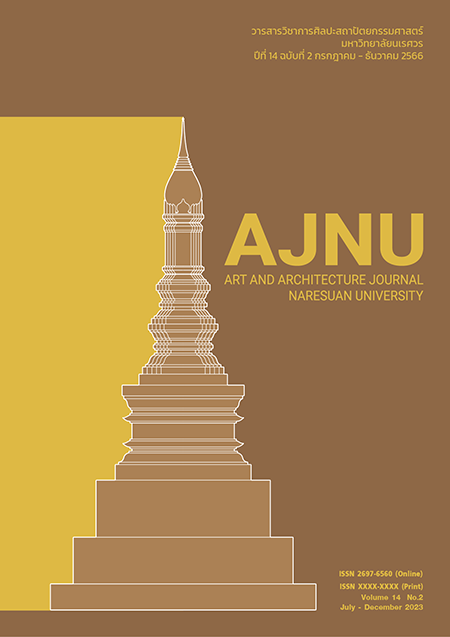Ceramic block wall design to improve comfort condition in building case study: Northeastern Region, Thailand
Main Article Content
Abstract
Thailand’s climate tends to rise every year due to global warming. Reducing the temperature inside buildings without the need of air-conditioning is a critical consideration for architects. Therefore, using materials that help reduce the temperature is essential in designing. In the past, clay water pots, which are earthenware ceramics, helped keep drinking water cool. Consequently, this principle was applied with the objective of designing ceramic blocks wall to adjust the comfort condition within residential buildings. Khon Kaen province was used as the case study to compare the comfort condition between the clay brick wall and lightweight concrete brick wall. The research result divided the ceramic block wall into two types. The first type used water to reduce the temperature, while the second used water in the first layer and left air gaps in the second layer to reduce heat and moisture. The two types consist of two sizes, 10x21x13 cm. and 10x20x60 cm., designed to stack to create more sturdiness with the ability to hold water, formed into ceramic blocks wall by casting clay in plaster molds and formed with clay plates. The raw materials were brisque fired at 800 degrees Celsius, glazed with ceramics, and then glazed fired at 1,100 degrees Celsius. The materials’ comfort condition was then compared with the clay wall bricks and lightweight concrete wall bricks. The temperature was measured using a Graphtec midi logger GL820, while the relative humidity was measured using a Digicon DL-TH-USB. The result from comparing the temperature within the test boxes of all four materials found that both ceramic blocks’ value has the temperature and relative humidity at a comfort condition (Temp 22-27 ◦C and RH 20-75%). The ceramic blocks have higher comfort condition when compared with the clay bricks and lightweight concrete wall blocks. Therefore, it can be concluded that ceramic blocks are more appropriate to be used as alternative wall blocks than the traditional materials to adjust the environment inside buildings to be closer to the comfort condition.
Article Details

This work is licensed under a Creative Commons Attribution-NonCommercial-NoDerivatives 4.0 International License.
References
แก้วกนก สุดจริง และยิ่งสวัสดิ์ ไชยะกุล. (2555). การควบคุมความชื้นในอาคารโดยผนังอาคาร. ขอนแก่น: คณะ
สถาปัตยกรรมศาสตร์ มหาวิทยาลัยขอนแก่น.
ชานนท์ ตันประวัติ. (2552). การออกแบบและพัฒนาเซรามิกที่ใช้ในการก่อผนังเพื่อการอนุรักษ์การใช้พลังงานภายในอาคาร.
กรุงเทพฯ: คณะสถาปัตยกรรมศาสตร์และการออกแบบ มหาวิทยาลัยเทคโนโลยีพระนคร.
นรากร พุทธโฆษ์ และชูพงษ์ ทองคำสมุทร. (2553). การพัฒนาผนังอาคารจากวัสดุเหลือใช้เพื่อปรับปรุงสภาวะน่าสบายใน
อาคาร กรณีศึกษาภาคตะวันออกเฉียงเหนือ ประเทศไทย. ขอนแก่น: คณะสถาปัตยกรรมศาสตร์มหาวิทยาลัยขอนแก่น.
สุนทร บุญญาธิการ. (2545). เทคนิคการออกแบบบ้านประหยัดพลังงานเพื่อคุณภาพชีวิตที่ดีกว่า. กรุงเทพฯ: ซีเอ็ด ยูเคชั่น.
อรรถ ชมาฤกษ์. (2551). สภาวะน่าสบายในเรือนพื้นถิ่นไท-เลย. ขอนแก่น: คณะสถาปัตยกรรมศาสตร์ มหาวิทยาลัยขอนแก่น.
ศูนย์ภูมิอากาศ กรมอุตุนิยมวิทยา. (2561). ความผันแปรและการเปลี่ยนแปลงสภาพภูมิอากาศ พ.ศ. 2560.
สืบค้นเมื่อ 9 พฤศจิกายน 2561. จาก http://climate.tmd.go.th/content/file/1329
ศูนย์ภูมิอากาศ กรมอุตุนิยมวิทยา. (2564). การสรุปลักษณะอากาศรายปี. สืบค้นเมื่อ 19 เมษายน 2566. จาก
http://climate.tmd.go.th/content/category/17
Fanger, P.O. (1970). Thermal comfort: analysis and applications in environment engineering. McGraw-
Hill, Co., New York.
Olgyay, V. (1963). Design with climate. bioclimatic approach, and architectural regionalism, New Jersey :
Princeton University Press.


